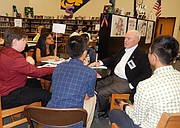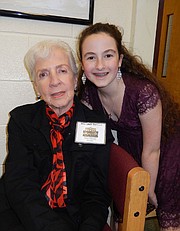From left are retired Army Colonels James Riffe and Jim Velezis Photo by Bonnie Hobbs.
Before Rocky Run Middle seventh-graders headed off for summer, they traveled back to the past via their school’s “World War II Oral History Day.” And this year’s event, the 15th annual, even had a new name, “iWitness to History Day.”
Spearheaded by history teacher Jamie Sawatzky, the June 9 extravaganza featured more than 130 eyewitnesses to some of the most important moments in U.S. history. When it first began, it focused on just one war. But over time, it grew to include veterans from the conflicts in Korea, Vietnam, Afghanistan and Iraq, as well as those who were at the Pentagon on 9/11.
They gave more than 250 group interviews to the students. Rocky Run also hosted seven, large-group presentations to more than 1,200 students and community members in the school theater. Among those sharing their stories were WW II veterans, plus civilians who were living in eight different countries then, including two Holocaust survivors and people forced to live in Japanese internment camps in America.
Another guest was Robert Shumaker, who served 36 years with the Navy, most notably in Vietnam, where his F-8 aircraft was shot down over Northern Vietnam in 1965. He spent the next eight years as a prisoner of war and coined the term, “Hanoi Hilton.”
Others included Chris Lovejoy, a Bosnian and Iraq wars veteran and a pilot of Marine One, the helicopter that flies the president; Les Kinsolving, who marched with Civil Rights leader Martin Luther King Jr.; Glen Bayless, who attended King’s “I Have A Dream Speech;” and Stuart Finley and Clayton Powell, who helped desegregate Virginia’s schools.
Col. Jim Velezis (ret.) served 30 years in the Army as a combat engineer, from 1963-93. He did two tours each in Germany and Vietnam and one tour in Korea. “We built roads, bridges, airfields and fighting positions — and destroyed the same things belonging to the enemy,” he said. “I commanded the largest engineer brigade in the Army.”
At Rocky Run for the first time, Velezis said, “They’re doing a wonderful thing, especially for the young kids, because we sit and talk to them. It’s important because we end up reliving history; and normally, we don’t pass on the impact and real, true meaning of this country’s heritage to the younger generation. The real meaning of service to the country isn’t transmitted to them, but this program conveys that.”
Retired Army Col. James Riffe was a college student in North Carolina when the Japanese bombed Pearl Harbor on Dec. 7, 1941. He registered for the draft in February 1942 and, that July, entered the Army as a private. Since he’d attended two years of ROTC and Citizens’ Military Training Camp, he was promoted to staff sergeant by December.
He then attended Officers Candidate School and was commissioned a second lieutenant. In 1944, he was sent to the Pacific island of Espiritos Santos with the 27th Infantry Division and went to Okinawa as a first lieutenant. He was an infantry platoon leader and company commander, an intelligence officer and a plans-and-operations officer.
“As a platoon leader, I had 35 men, ages 18-19,” said Riffe. “Seven got killed and 10 of them plus me got wounded. So what I remember most was my men. I remember standing next to someone who got killed and feeling the bullets whizzing by my head — and those memories are still as fresh to me today as they were in 1945.”
As for Rocky Run’s history event, he said, “I wish it were expanded throughout all the schools in Virginia and the country. It’s important because, the more our young people learn about the wars, the tragedies, the loss and the [human] cost, the greater our efforts will be to avoid war.”
Also there was Linda Bernson, 76, whose granddaughter, Eryn Cohen, attends Rocky Run. “This is a wonderful program because the kids are being taught to be interested in history,” said Bernson. “And we see that, as much as things have changed, they’re still the same — what teens are thinking and feeling and the issues they deal with.”
“I lived through the Cuban Missile Crisis and was at Cape Canaveral during the rocket launches — which the kids were unimpressed with because it’s something they’re used to seeing,” she said. “And when I told them that, when I went to college, I wasn’t allowed to take a business course because I was a woman, they couldn’t relate to that. They also didn’t understand why it’s so historic that a woman will be a presidential nominee.”
However, said Bernson, “They wanted to know my reactions to 9/11. They also wanted my advice to them, so I said, ‘Put down your machines and listen.’”
A press aide in Vietnam, Theda Parrish worked for the U.S. Public Affairs office in Saigon from 1966-68, doing a daily briefing for the press corps. “I was working in Washington with the Voice of America and they needed volunteers to go to Vietnam,” she said. “We had no electric typewriters or computers; we did everything by hand.”
Vietnamese citizens worked in her office, too. “They told us, ‘For 3,000 years, people have invaded our country and forced us to do things we didn’t want to do. So we’re used to it and we know you’ll only be here for a year,’” said Parrish. “But being in Vietnam was life-changing; after that, everything seemed kind of trivial. The Tet Offensive, when the embassy was being attacked, was near my home and I was afraid.”
She said Americans remember that war much differently than do the Vietnamese. “We lost 58,000 people, and our wounded got good medical care,” she said. “But the Vietnamese didn’t have the modern, medical technology that we did, so they lost a million people. And when we said ‘collateral damage’ because a bomb or something else went wrong, we didn’t understand that, to the Vietnamese, it meant the deaths of women, children and old people.”
Rocky Run’s “iWitness to History” event is significant, said Parrish, because “If you don’t study history, you’re doomed to repeat it — and it seems like every generation does repeat it. And with an all-volunteer Army — and Congress not having to serve in the military — it’s easy to send other people’s kids to battle, but not your own. So I believe everybody should have to serve the country some way, in the Peace Corps, military, as a teacher, etc., so everyone has a stake in their country.”
She told the students they should learn about history so they could someday be in Congress and “make the decisions about going to war or spending more money on peace. I now work with the severely wounded at Walter Reed [hospital], finding them jobs. Some make it and some commit suicide due to post-traumatic stress. They may not have been physically hit by an IED, but their brain has. The constant deployments and exposure to war have damaged them. So maybe you guys can help stop this.”



